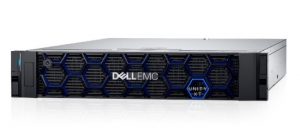This is the third release update to Dell EMC PowerOne since our launch, highlighting our commitment to rapid innovation. And while Dell EMC Unity XT integration is the highlight of this release, I’d like to point out a few of the other ongoing innovations now available to users:
- Realistic elevations in the PowerOne Navigator
- Improved progress reporting & logging
- Component updates across the storage, compute and networking stacks
So, what does this mean for our customers? Releases like this tie back to one of the core values of PowerOne: it is built as an all-in-one system. Users will have more insight into the physical and virtual operations as they are occurring, and as always that information can be passed via API to their tools of choice. Component updates across the full stack give our customers peace of mind, removing the burden of lifecycle management.
The introduction of Unity XT midrange storage means that PowerOne expands autonomous  operations into a broader range of Dell EMC products and extends infrastructure flexibility. PowerOne with Unity XT enables users to consolidate more workloads, start with a smaller footprint, and lower the cost of entry. Taking advantage of the unique system level management of PowerOne, Unity XT can be declaratively configured through the single system-level GUI or API allowing for integration into existing data center toolsets and a true Infrastructure-as-Code experience. At the same time, customers have access to directly control the array, giving them the ability to adopt automation at their pace. Unity XT shines in the following areas:
operations into a broader range of Dell EMC products and extends infrastructure flexibility. PowerOne with Unity XT enables users to consolidate more workloads, start with a smaller footprint, and lower the cost of entry. Taking advantage of the unique system level management of PowerOne, Unity XT can be declaratively configured through the single system-level GUI or API allowing for integration into existing data center toolsets and a true Infrastructure-as-Code experience. At the same time, customers have access to directly control the array, giving them the ability to adopt automation at their pace. Unity XT shines in the following areas:
- Workload consolidation – As IT leaders look to accommodate growth in the data center, workload consolidation is one of the best ways to reduce silos, gain efficiencies and leverage expensive real estate. The addition of Unity XT midrange storage means customers can run a mix of high performance and low latency workloads in a single automated system.
- Scale and Agility – PowerOne with Unity XT enables customers to start smaller and grow larger and helps administrators provide the right mix of performance and efficiency for use in their data center.
- Lower cost of entry and flexible consumption – The mantra of IT is “do more with less.” PowerOne with Unity XT balances performance, density and cost helping our customers address this with a lower cost of entry and offering pay-as-you-go financial models to convert CAPEX to OPEX.
Stay on the lookout for more innovation this year as we continue to expand the capabilities and use cases of PowerOne.
One of the features we probably don’t highlight enough is the ability of PowerOne to offer both operational consistency and flexibility. For users who are ready to adopt infrastructure automation, PowerOne provides a single API to manage most aspects of initialization, day 1 production cluster start-up as well as lifecycle management and expansion. For users who still need granular control of some or all components within the system the element managers of each component are still available for direct login so they can manually set parameters.
Dell Technologies has built the infrastructure automation, so you don’t have to. We provide deep integration, writing API hooks into each component (server, storage and networking) ensuring that they are all interoperable. This saves time and money by setting a strategy, identifying and configuring tools and writing thousands of lines of code. And Dell Technologies commitment to maintain and update the code, as well as introduce new technology into the system as it becomes available, ensures that the day 2+ operations are as automated as possible, reducing OPEX and technical debt.
Now that Unity XT is part of PowerOne, users can drive adoption and productivity faster without having to learn how to operate and manage a new component. And as part of the consistent operations of PowerOne they can take advantage of the flexibility and efficiency to begin immediately running new workloads.
Please take a few minutes to look at the ESG whitepaper or video review below of how PowerOne’s automation features can significantly decrease the manual work typically required to configure, deploy, and administer data center IT architecture.
